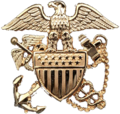United States Public Health Service Commissioned Corps
Federal uniformed service of the U.S. Public Health Service
The United States Public Health Service Commissioned Corps (PHSCC) is a federal uniformed service of the United States Public Health Service (PHS), under the Department of Health and Human Services (HHS). The PHSCC is one of the eight uniformed services of the United States and is led by the Surgeon General of the United States.
History[edit]
The origins of the PHSCC date back to the establishment of the Marine Hospital Service in 1798, which was created to provide health care to sick and injured merchant seamen. Over time, the service expanded its mission and scope, eventually becoming the Public Health Service in 1912. The Commissioned Corps was formally established in 1889, providing a cadre of health professionals to respond to public health needs.
Mission[edit]
The mission of the PHSCC is to protect, promote, and advance the health and safety of the nation. Officers in the Corps are involved in a wide range of public health activities, including disease control and prevention, biomedical research, regulation of food and drugs, mental health and substance abuse services, and health care delivery.
Organization[edit]
The PHSCC is led by the Surgeon General of the United States, who is appointed by the President of the United States. The Corps is composed of over 6,000 commissioned officers who serve in various roles across the federal government, including the Centers for Disease Control and Prevention (CDC), the Food and Drug Administration (FDA), and the National Institutes of Health (NIH).
Ranks and Insignia[edit]
The PHSCC uses the same rank structure as the United States Navy, with ranks ranging from Ensign (O-1) to Admiral (O-10). Officers wear uniforms similar to those of the Navy, with distinct insignia and devices that identify them as members of the PHSCC.
Uniforms[edit]
Officers of the PHSCC wear a variety of uniforms depending on their duties and the occasion. These include the service dress blues, summer whites, and summer khakis. The uniforms are similar in style to those of the Navy but include unique insignia and devices.
Deployments[edit]
The PHSCC is often deployed in response to public health emergencies, both domestically and internationally. Officers have been involved in responses to natural disasters, disease outbreaks, and other public health crises. Notable deployments include the response to the Ebola outbreak in West Africa and the COVID-19 pandemic.
Related pages[edit]
- Surgeon General of the United States
- United States Department of Health and Human Services
- Centers for Disease Control and Prevention
References[edit]
- "Doctrine for the U.S. Public Health Service Commissioned Corps, January 2021." [PDF document].
- "A Day in the Life of LCDR Abigail - USPHS Commissioned Corps Mascot." [Webm video].
- "U.S. Public Health Service Commissioned Corps Ready Reserve Video." [Webm video].
Gallery[edit]
-
Seal of the USPHS Commissioned Corps
-
Presidential Unit Citation
-
Cap device
-
Collar device
-
Lapel pin
-
Flag of the Assistant Secretary for Health
-
Flag of the Surgeon General
-
Flag of the Deputy Surgeon General
-
Flag of a 2-Star Assistant Surgeon General
-
Flag of a 1-Star Assistant Surgeon General
-
Service dress blues
-
Summer whites
-
Summer khakis
-
Operation United Assistance 2014
Ad. Transform your life with W8MD's Budget GLP-1 injections from $75


W8MD offers a medical weight loss program to lose weight in Philadelphia. Our physician-supervised medical weight loss provides:
- Weight loss injections in NYC (generic and brand names):
- Zepbound / Mounjaro, Wegovy / Ozempic, Saxenda
- Most insurances accepted or discounted self-pay rates. We will obtain insurance prior authorizations if needed.
- Generic GLP1 weight loss injections from $75 for the starting dose.
- Also offer prescription weight loss medications including Phentermine, Qsymia, Diethylpropion, Contrave etc.
NYC weight loss doctor appointmentsNYC weight loss doctor appointments
Start your NYC weight loss journey today at our NYC medical weight loss and Philadelphia medical weight loss clinics.
- Call 718-946-5500 to lose weight in NYC or for medical weight loss in Philadelphia 215-676-2334.
- Tags:NYC medical weight loss, Philadelphia lose weight Zepbound NYC, Budget GLP1 weight loss injections, Wegovy Philadelphia, Wegovy NYC, Philadelphia medical weight loss, Brookly weight loss and Wegovy NYC
|
WikiMD's Wellness Encyclopedia |
| Let Food Be Thy Medicine Medicine Thy Food - Hippocrates |
Medical Disclaimer: WikiMD is not a substitute for professional medical advice. The information on WikiMD is provided as an information resource only, may be incorrect, outdated or misleading, and is not to be used or relied on for any diagnostic or treatment purposes. Please consult your health care provider before making any healthcare decisions or for guidance about a specific medical condition. WikiMD expressly disclaims responsibility, and shall have no liability, for any damages, loss, injury, or liability whatsoever suffered as a result of your reliance on the information contained in this site. By visiting this site you agree to the foregoing terms and conditions, which may from time to time be changed or supplemented by WikiMD. If you do not agree to the foregoing terms and conditions, you should not enter or use this site. See full disclaimer.
Credits:Most images are courtesy of Wikimedia commons, and templates, categories Wikipedia, licensed under CC BY SA or similar.
Translate this page: - East Asian
中文,
日本,
한국어,
South Asian
हिन्दी,
தமிழ்,
తెలుగు,
Urdu,
ಕನ್ನಡ,
Southeast Asian
Indonesian,
Vietnamese,
Thai,
မြန်မာဘာသာ,
বাংলা
European
español,
Deutsch,
français,
Greek,
português do Brasil,
polski,
română,
русский,
Nederlands,
norsk,
svenska,
suomi,
Italian
Middle Eastern & African
عربى,
Turkish,
Persian,
Hebrew,
Afrikaans,
isiZulu,
Kiswahili,
Other
Bulgarian,
Hungarian,
Czech,
Swedish,
മലയാളം,
मराठी,
ਪੰਜਾਬੀ,
ગુજરાતી,
Portuguese,
Ukrainian












